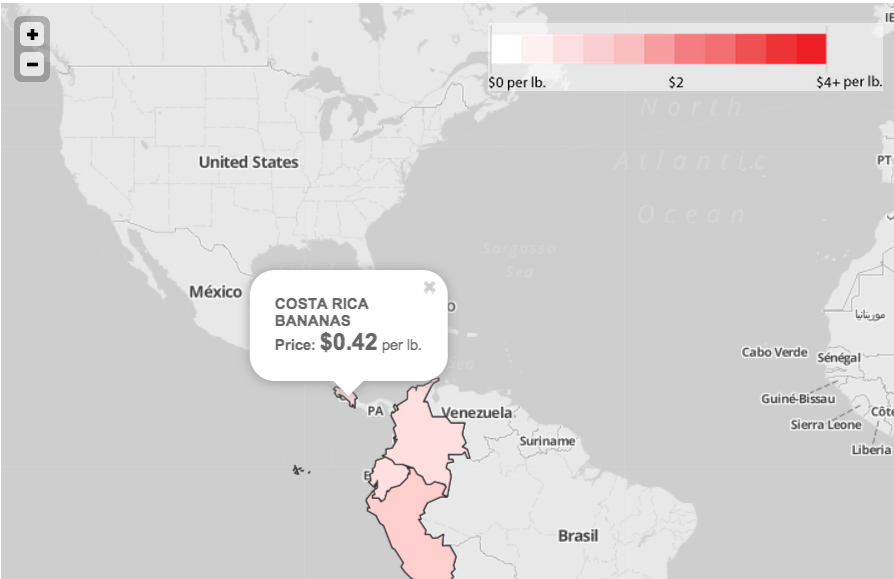Curious about the wholesale price of those bananas that you picked up at your neighborhood bodega? Now, with data from the U.S. Department of Agriculture and the Hunts Point Terminal Produce Market, a clear and effective interactive food map is available for users. You can enter the name of any fruit or veggie, find out the wholesale price, and locate the country of origin on the globe. The information shifts by season, as our food sources move based on harvests. The map provides a comprehensive glimpse into New York City’s food supply and distribution base.
The map shows that a large proportion of produce entering Hunts Point, on its way to a green grocer or bodega near you, is not exactly locally sourced. Enter iceberg lettuce into the map’s search bar, and see that it is sourced from California and New Mexico, for $0.26/lb. Bananas are sourced from Colombia, Ecuador, Costa Rica and Guatemala for anywhere between $0.36/lb to $0.53/lb, and kiwis come from Chile.
As the world’s largest food distribution center, the Hunts Point Terminal Produce Market operates on 690 acres in the South Bronx, a mismatch of open air tents, industrial buildings and refrigerated truck trailers. The market now processes 22% of the region’s wholesale produce sales, or 60% of fruit and vegetable sales in New York City. While this may seem like an impressive statistic, in 1989 Hunts Point captured over 75% of the wholesale produce sales in the region. The reason for the drop in sales since then? Chain stores. Large scale retailers such as Whole Foods, with their own distribution systems, have increasingly located their distribution centers outside of New York City, where rent is lower and space is more available. Hunts Point Market now draws its primary consumer base from small businesses and bodegas that are dependent on the market’s cheap produce.
Does it matter that so much of our healthy food is crossing such huge distances to reach us? That depends on the crop and the method of shipping. Bananas, for example, are a relatively efficient food. Kiwis from New Zealand could have smaller footprints if kites can help propel the cargo ships that carry them — and growers are beginning to consider the question.
Local agriculture does not necessarily come with a smaller footprint, because the farming methods and delivery systems (pick-up trucks driving small loads down from upstate New York, for example) may be much more carbon-intensive than long distance rail or cargo ships, which are remarkably green methods of transport.

The food map has been hailed as data collection done right; instead of cataloging produce as domestic when an item is shipped from the entry city to another U.S. city, data from Hunts Point accurately labels the item as international. The map shows the global reach of New York City’s food distribution system, and also shows that New York City remains far from regional food self-sufficiency.
The city has proposed a $332.5 million redevelopment project for the market, and there is little mention of incorporating local food distributors into the market’s network. The project plans to maximize land use on the property by expanding and upgrading the market, as well as updating on-site food safety. Read the Hunts Point Vision NYCEDC plan here, and more about Hunts Point in the New York World. Hunts Point is also included in the city’s discussion of critical networks, in the Special Initiative on Rebuilding and Resiliency (SIRR) report.
